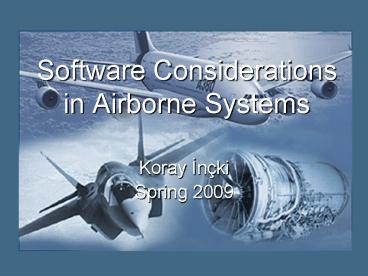Software Considerations in Airborne Systems - PowerPoint PPT Presentation
1 / 23
Title:
Software Considerations in Airborne Systems
Description:
Safety is a property of a system that it will not endanger human life or the environment. ... and relationship to system and software lifecycle for commercial avionics ... – PowerPoint PPT presentation
Number of Views:212
Avg rating:3.0/5.0
Title: Software Considerations in Airborne Systems
1
Software Considerations in Airborne Systems
- Koray Inçki
- Spring 2009
2
Safety-critical?
- Safety
- Safety is a property of a system that it will
not endanger human life or the environment. - Safety-Critical System
- A system that is intended to achieve, on its
own, the necessary level of safety integrity for
the implementation of the required safety
functions.
3
What is DO-178B?
- Overview
- RTCA
- Software use in Airborne Systems
- Not a Process document instead a discussion of
the certification process and relationship to
system and software lifecycle for commercial
avionics - A guideline of best practices for safety critical
software development on airborne systems
4
DO-178B Overview
- In 1985, revisions and updates were made to
produce DO-178A / ED-12A. - The documents became a worldwide basis for
software certification in the aviation industry - Three basic Software Lifecycle Processes
- Software Planning Process
- Software Development Process
- Correctness, Confidence Control Process
5
Guidelines
- The guidelines in DO-178B impose constraints on
the software development process so that the
resulting system is safe. - The FAAs DO-178B offers guidelines for the
development of airborne systems equipment
software. - Most RTOS tool vendors have accepted the
guidelines in DO-178B and begun to offer tool
support.
6
What are we dealing with?
7
DO-178B Document Layout
8
DO-178B Software Levels
9
DO-178B Processes and Outputs
- DO-178B is divided into six main processes
- Software Planning Processes
- Software Development Processes
- Software Verification Processes
- Software Configuration Management Processes
- Software Quality Assurance Processes
- Certification Liaison Processes
- Each process has a set of expected documented
outputs.
10
Software Planning Process
- Activities addressing system requirements and
certification levels - Inter-relationships between processes,
sequencing, feedback, and transition criteria - Lifecycle environment, including methods and
tools - Software development standards
- Software plans that comply with DO178B
- Coordination of development and revisions to plans
11
Software Planning Process Outputs
- Plan for software aspects of certification (PSAC)
- Software development plan (SDP)
- Software verification plan (SVP)
- Software configuration management plan (SCMP)
- Software quality assurance plan (SQAP)
- System requirements
- Software requirements Specifications(SRS)
- Software design standard (SDS)
- Software code standard (SCS)
12
Software Development Process
- The software development process is broken into
four sub-processes - Software Requirements Process
- High-level requirements in relation to function,
performance, interface and safety. - Software Design Process
- Low-level requirements used to implement the
source code. - Software Coding Process
- Production of source-code from the design
process. - Integration Process
- Integration of code into a real-time environment.
13
Software Development Process Outputs
- The following tangible outputs are the result of
the combined four sub-processes - Software requirements data (SRD)
- Software design description (SDD)
- Source code
- Executable object code
14
Software Verification Process
- The purpose is to identify and report any errors
resulting from the development process. - The verification process objectives can be met
with reviews, walkthroughs, unit testing,
integration testing, and more. - Proof of objectives is within the execution of
the testing procedures. - Outputs include
- Software verification cases and procedures (SVCP)
- Software verification results (SVR)
- Review of all requirements, design and code
- Testing of executable object code
- Code coverage analysis
15
Software Verification Process..
16
Software Configuration Management Process
- The purpose is to establish secure and effective
configuration control for all artifacts. - The following activities are done within the
process - Configuration Identification
- Change Control
- Baseline establishment
- Archiving of the software
- Outputs include
- Software configuration index (SCI)
- Software life cycle environment configuration
index (SECI)
17
Software Quality Assurance Process
- The purpose is to provide assurance that the
software life cycle process is going to yield
quality software. - Each process is analyzed to show that each
process is producing the expected outputs. - Any changes from originally proposed plans are
reported, evaluated, and resolved to ensure
process integrity.
18
Software Quality Assurance Process
- Outputs
- Software quality assurance records (SQAR)
- Software conformity review (SCR)
- Software accomplishment summary (SAS)
19
DO-178B Certification
- Typically a Designated Engineering Representative
(DER) working for e.g. FAA in an airplane
manufacturing company. - D0-178B very specifically addresses the following
which directly affects product development. - Certification of a product applies only to it's
finished result. - Certification includes approval of all systems
and subsystems, hardware, software, firmware,
development tools, production, and testing of the
product. - Certification is done on the individual
application of the product - Coding practices must be certified to ensure
things like "dead code" are not allowed. - Certification requires that 'full testing' of the
system and all of it's components (including
firmware) be done on the target platform in the
target environment. - Certification requires code testing at the MCDC
level.
20
A RTOS Perspective of DO-178B
21
Development Tools
22
References
- DO-178B, Software Considerations in Airborne
Systems and Equipment Certification. Wikipedia
The Free Encyclopedia. 13.May.2009. Wikimedia
Foundation, Inc. June 2003. http//en.wikipedia.or
g/wiki/DO178B - Johnson, Leslie A. (Schad). DO-178B, Software
Considerations in Airborne Systems and Equipment
Certification. Flight Systems. 4 March 2007.
Boeing Commercial Airplane Group. 4 March 2007.
http//www.stsc.hill.af.mil/crosstalk/1998/10/scha
d.asp - RTCA/DO-178B, "Software Considerations in
Airborne Systems and Equipment Certification,"
December 1, 1992 - http//www.highrely.com
23
Have a safe flight!































